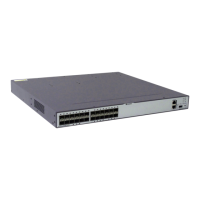#
sysname Switch C
#
ipv6
#
vlan batch 20 30
#
interface Vlanif20
ipv6 enable
ipv6 address 1000::2/64
ospfv3 1 area 0.0.0.1
#
interface Vlanif30
ipv6 enable
ipv6 address 1002::1/64
ospfv3 1 area 0.0.0.0
#
interface XGigabitEthernet0/0/1
port hybrid pvid vlan 30
port hybrid untagged vlan 30
#
interface XGigabitEthernet0/0/2
port hybrid pvid vlan 20
port hybrid untagged vlan 20
#
ospfv3 1
router-id 3.3.3.3
area 0.0.0.1
vlink-peer 2.2.2.2
#
return
l Configuration file of Switch D
#
sysname Switch D
#
ipv6
#
vlan batch 30
#
interface Vlanif30
ipv6 enable
ipv6 address 1002::2/64
ospfv3 1 area 0.0.0.0
#
interface XGigabitEthernet0/0/2
port hybrid pvid vlan 30
port hybrid untagged vlan 30
#
ospfv3 1
router-id 4.4.4.4
#
return
5.12.4 Example for Configuring OSPFv3 GR
Networking Requirements
As shown in Figure 5-4, Switch A, Switch B, and Switch C belong to the same OSPFv3 area.
They communicate with each other through the OSPFv3 protocol and are enabled with GR.
When OSPFv3 adjacencies are established between Switch A, Switch C, and Switch B, the three
switches can exchange routing information. If the OSPFv3 protocol restarts on Switch A, Switch
A synchronizes data with the neighboring switches through GR.
S6700 Series Ethernet Switches
Configuration Guide - IP Routing 5 OSPFv3 Configuration
Issue 01 (2012-03-15) Huawei Proprietary and Confidential
Copyright © Huawei Technologies Co., Ltd.
228

